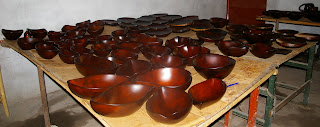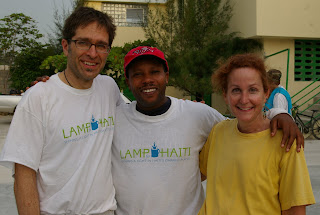
Jacqualine Labrom, a wonderful travel and tourism agent, had shared her passion for the artistry of Einstein Albert, the second-generation owner of a local woodworking business, with me. I was eager to go, especially before heading home on leave. I have a special wedding to attend in July and wanted to select something handcrafted in Haiti. This was going to provide me the perfect opportunity.
Jacqualine picked me up around 10 a.m. There were five other people joining us, three of whom were staff members from the United Nations. We proceeded through Leogane and Carrefour, driving about 40 minutes. At a certain point, the driver u-turned and then accessed a small side road. As is so often the case here, you proceed down an alley like road where there seems to be little of interest. Suddenly, however, you turn a corner and find that you have discovered one of Haiti’s treasures.
Einstein greeted us at the gate. He first took us the open-air work area where some of the women were sanding pieces in various stages of production. Einstein began with the family history. His parents came to Haiti from Jamaica in the 1940’s. They founded the woodworking business. As word spread of the quality and craftsmanship of their product and demand increased, it was suggested that they develop their own tree plantations. They settled on the Obechee tree, a kind of gum tree. They chose this tree for a couple reasons. It was a soft wood and, therefore, not viable for making charcoal. It was also very fast growing. Within 9 years, an Obechee tree can have a circumference of 90”. They now have multiple tree plantations from which they draw their wood.

They woodworking center averages 40 employees although, at their busiest times, they employ as many as 80. 60% of their work force is women. The women are primarily responsible for the sanding. The men are engaged in aspects of production requiring heavier labor.
Every piece is of the highest quality. The varnishes are produced organically from other trees. The color of the varnish varies with each species of tree and therefore affects the color of the final product. Each piece is varnished 13 times and then receives a final matte. This enables all the products to be used for food. They are also temperature resistant. In addition, the pieces are specially treated against termites. This is particularly important given the softness of the wood.

Einstein shared the story of one of his most popular pieces. Some years ago, he attended a special gift convention in New York City. A woman came to his booth and raved about his work. As beautiful as everything was in his display, she was interested in finding something unique. Einstein asked her if she had an idea of what she wanted. She said yes, borrowed his pen and sketched it for him. He said he could have it produced in two week and shipped to the U.S. She handed him her card and told him to contact her at her hotel when it arrived.
After the woman left, the person in the booth next to Einstein said “Didn’t you know who that was?” Einstein said no and looked at the card. It was Lady Diana! The bowl arrived, as promised, two weeks later. He delivered the bowl to the hotel. When Lady Diana asked for the price, Einstein said that it was a gift. In exchange, he asked permission to associate her name with the design. To this day, it is known as the Diana bowl.

Einstein has a great business sense. While not sacrificing quality, he is coming up with some new, simpler designs to keep costs down during the recession. One of his innovations is what he calls a plate. It is available in various sizes, about ½” thick and can serve any number of functions. I bought a small one to use as a cheese board.
Today was both delightful and informative. It I always heartening to witness successful, family owned businesses that also provide important employment opportunities for the community. Einstein is a remarkable man, open to sharing his gifts and collaborating with others. He entrepreneurial spirit demonstrates hope and promise for Haiti’s future.

















